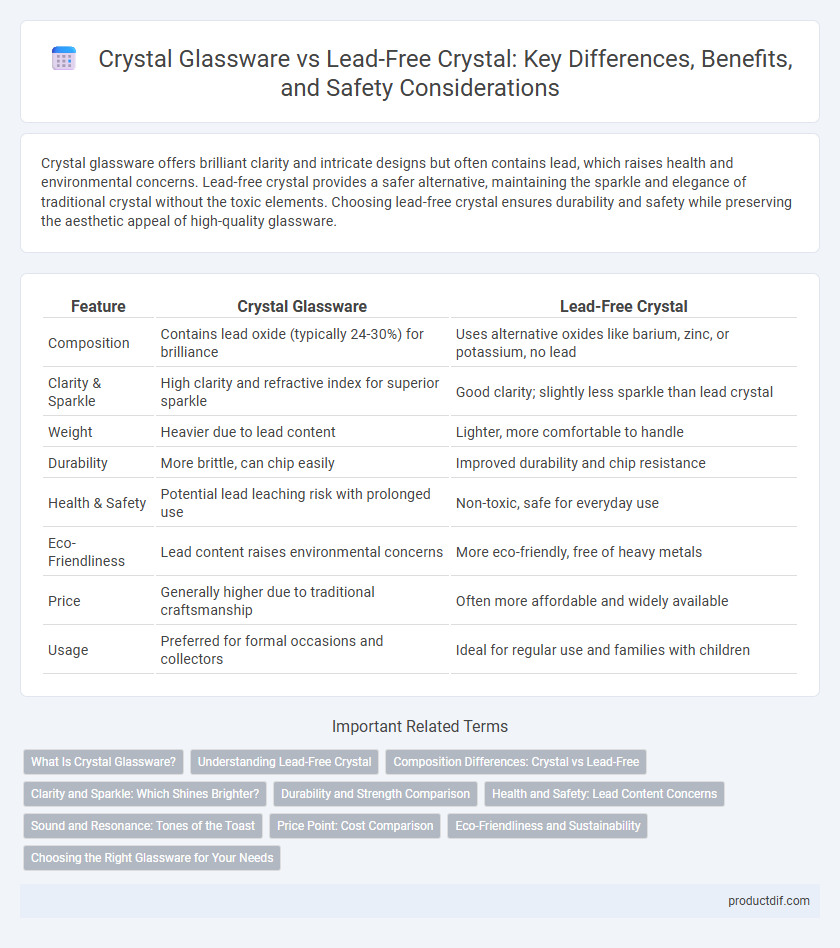Crystal glassware offers brilliant clarity and intricate designs but often contains lead, which raises health and environmental concerns. Lead-free crystal provides a safer alternative, maintaining the sparkle and elegance of traditional crystal without the toxic elements. Choosing lead-free crystal ensures durability and safety while preserving the aesthetic appeal of high-quality glassware.
Table of Comparison
| Feature | Crystal Glassware | Lead-Free Crystal |
|---|---|---|
| Composition | Contains lead oxide (typically 24-30%) for brilliance | Uses alternative oxides like barium, zinc, or potassium, no lead |
| Clarity & Sparkle | High clarity and refractive index for superior sparkle | Good clarity; slightly less sparkle than lead crystal |
| Weight | Heavier due to lead content | Lighter, more comfortable to handle |
| Durability | More brittle, can chip easily | Improved durability and chip resistance |
| Health & Safety | Potential lead leaching risk with prolonged use | Non-toxic, safe for everyday use |
| Eco-Friendliness | Lead content raises environmental concerns | More eco-friendly, free of heavy metals |
| Price | Generally higher due to traditional craftsmanship | Often more affordable and widely available |
| Usage | Preferred for formal occasions and collectors | Ideal for regular use and families with children |
What Is Crystal Glassware?
Crystal glassware is characterized by its high clarity and brilliance, traditionally achieved by adding lead oxide to the glass mixture, which enhances weight, refractive index, and sparkle. Lead-free crystal glassware substitutes lead with alternative oxides such as barium, potassium, or zinc, maintaining similar brilliance and durability while offering a safer, environmentally friendly option. Both types provide superior clarity and elegance compared to regular glass, making them preferred choices for fine dining and decorative purposes.
Understanding Lead-Free Crystal
Lead-free crystal glassware offers a safer alternative to traditional lead crystal by eliminating lead oxide while maintaining brilliance and clarity through the use of alternative metal oxides like barium or zinc. This type of crystal remains highly durable and resistant to chipping, making it suitable for everyday use without health concerns associated with lead exposure. Understanding the composition and benefits of lead-free crystal helps consumers choose elegant, non-toxic glassware that meets modern safety standards.
Composition Differences: Crystal vs Lead-Free
Crystal glassware contains lead oxide, typically ranging from 24% to 30%, which enhances its brilliance, weight, and refractive qualities. Lead-free crystal replaces lead oxide with alternative metal oxides such as barium oxide, zinc oxide, or potassium oxide, maintaining similar clarity and sparkle while being more environmentally friendly and safer for health. The composition differences directly affect durability, light dispersion, and the overall aesthetic of the glassware.
Clarity and Sparkle: Which Shines Brighter?
Crystal glassware offers exceptional clarity and brilliance due to its higher refractive index, typically enhanced by lead content that creates a distinctive sparkle. Lead-free crystal, although lacking lead, achieves comparable clarity through alternative materials like barium or zinc oxides, resulting in vibrant sparkle while being safer and more environmentally friendly. When comparing both, traditional lead crystal often shines brighter with deeper refractions, but modern lead-free options provide impressive brilliance and clarity suitable for elegant glassware collections.
Durability and Strength Comparison
Crystal glassware typically contains lead oxide, which enhances clarity but can reduce durability, making it more prone to chips and cracks over time. Lead-free crystal uses alternative materials like barium or potassium oxides, offering greater strength and resistance to breakage while maintaining a high level of brilliance. This makes lead-free crystal glassware a more durable and practical choice for everyday use compared to traditional lead crystal.
Health and Safety: Lead Content Concerns
Crystal glassware traditionally contains lead, which can pose health risks due to lead leaching into beverages over time, especially with acidic or prolonged contact. Lead-free crystal glassware eliminates these concerns by using alternative materials such as barium or zinc to achieve similar clarity and brilliance without toxic lead content. Choosing lead-free crystal ensures safer consumption and complies with strict regulatory standards for lead exposure in drinkware.
Sound and Resonance: Tones of the Toast
Crystal glassware produces a distinct, long-lasting resonance characterized by a clear, ringing tone that enhances the experience of toasting. Lead-free crystal, while offering safer chemical composition, often emits a slightly softer sound due to differences in density and composition. The tonal clarity and sustained vibration in traditional lead crystal remain favored for their auditory elegance during celebratory moments.
Price Point: Cost Comparison
Crystal glassware generally commands a higher price due to the inclusion of lead oxide, which enhances clarity and brilliance but raises production costs and shipping regulations. Lead-free crystal offers a more affordable alternative by utilizing non-toxic materials such as barium or potassium oxides, maintaining similar visual appeal with lower manufacturing expenses. Consumers seeking budget-friendly options often prefer lead-free crystal for its cost-effectiveness without compromising aesthetic quality.
Eco-Friendliness and Sustainability
Lead-free crystal glassware offers a more eco-friendly and sustainable alternative to traditional lead crystal by eliminating toxic lead content, reducing environmental and health hazards during manufacturing and disposal. The production of lead-free crystal typically involves lower energy consumption and fewer harmful emissions, aligning with green manufacturing practices. Its recyclability and non-toxic composition contribute significantly to reducing environmental impact, making it a responsible choice for eco-conscious consumers.
Choosing the Right Glassware for Your Needs
Crystal glassware offers unmatched brilliance and weight due to its lead content, enhancing the visual appeal and tactile experience of fine dining. Lead-free crystal provides a safer, eco-friendly alternative with comparable clarity and durability, ideal for everyday use or households concerned with health risks. Selecting between traditional leaded and lead-free crystal depends on prioritizing either luxury aesthetics or practical safety and environmental considerations.
Crystal Glassware vs Lead-Free Crystal Infographic

 productdif.com
productdif.com